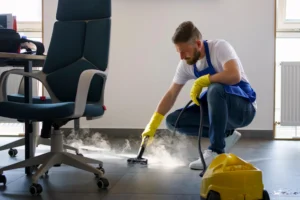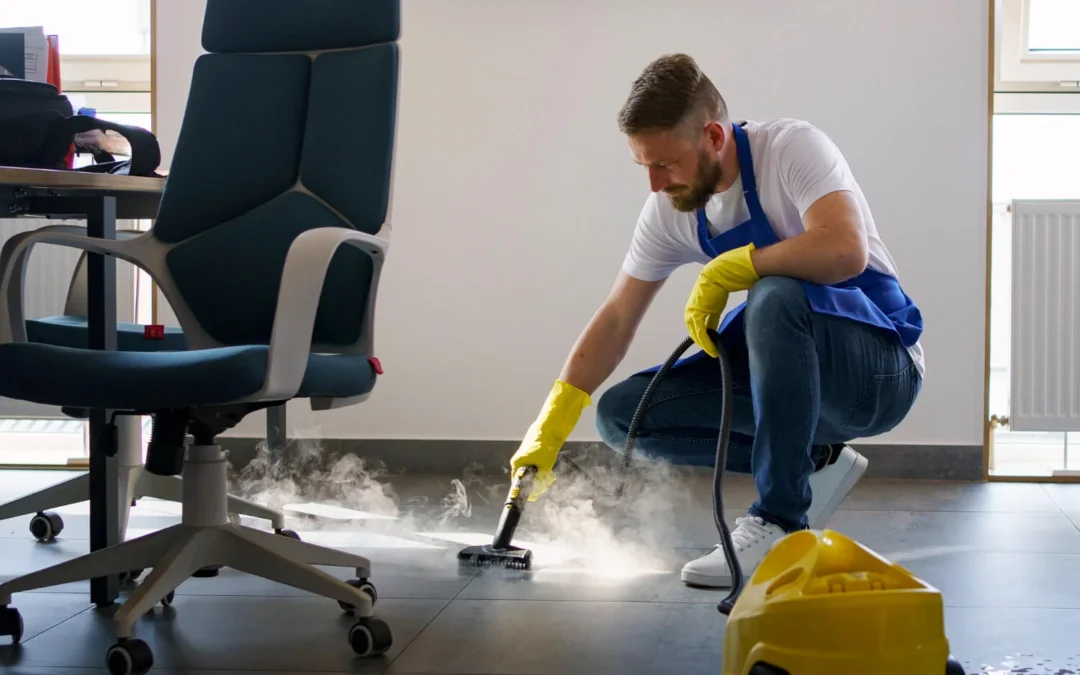Maintaining a clean and sanitized work environment is crucial not only for aesthetics but also for the health and well-being of employees. Regular cleaning helps prevent the spread of germs, allergens, and harmful bacteria, which can lead to various health issues, from common colds to more severe respiratory infections. This comprehensive guide explores how a consistent cleaning routine can contribute to a healthier workplace, enhance productivity, and reduce absenteeism.

Regular Cleaning Can Prevent Health Issues at Work
The Health Risks of a Dirty Workplace
A dirty workplace can be a breeding ground for bacteria, viruses, and allergens. Dust, mold, and chemical residues can accumulate on surfaces, in carpets, and air ducts, leading to poor indoor air quality. This can cause or exacerbate respiratory problems such as asthma, allergies, and even chronic bronchitis. High-touch areas like doorknobs, keyboards, and shared equipment are particularly prone to germ accumulation, increasing the risk of spreading infections.
- Common Health Issues: The most common health problems resulting from poor office hygiene include respiratory issues, skin irritations, and gastrointestinal infections. Regular exposure to dust, mold, and other allergens can also trigger asthma attacks or cause new respiratory problems in otherwise healthy individuals.
- Impact on Productivity: Health issues linked to poor cleanliness directly affect productivity. Employees who frequently fall ill or experience allergy symptoms are more likely to take sick leave, disrupting workflow and impacting overall productivity. A clean work environment helps maintain a healthier workforce, reducing absenteeism and improving morale.
How Regular Cleaning Prevents Health Problems
A well-maintained office with a routine cleaning schedule can significantly reduce health risks. Here’s how regular cleaning contributes to a healthier workplace:
- Reduces the Spread of Germs: Regular cleaning and disinfecting of high-touch surfaces, such as desks, phones, keyboards, and communal areas, minimize the spread of germs. This is particularly important during cold and flu season or when contagious diseases are prevalent.
- Improves Air Quality: Regular vacuuming with HEPA filters, dusting, and air duct cleaning can improve indoor air quality by removing dust, mold, and other airborne allergens. Improved air quality reduces the risk of respiratory issues and promotes a more comfortable work environment.
- Prevents Mold Growth: Mold can thrive in damp, poorly ventilated areas and can cause serious health problems, including respiratory issues and skin irritations. Regular inspection and cleaning of areas prone to moisture, such as bathrooms and kitchens, prevent mold growth and maintain a safe, healthy environment.
- Minimizes Allergens: Routine cleaning helps remove common allergens, such as dust mites, pollen, and pet dander, from office environments. This is particularly beneficial for employees who suffer from allergies or asthma, reducing symptoms and improving comfort.
- Promotes Mental Well-being: A clean and organized workspace can also positively affect mental health. Clutter and dirt can contribute to stress and anxiety, while a clean environment promotes a sense of calm and focus, enhancing overall well-being and productivity.
Effective Cleaning Strategies for a Healthier Workplace
Implementing a comprehensive cleaning strategy is key to maintaining a healthy workplace. Here are some practical steps to consider:
- Develop a Cleaning Schedule: Create a regular cleaning schedule that includes daily, weekly, and monthly tasks. Daily tasks should focus on high-touch surfaces and common areas, while weekly and monthly tasks can include deep cleaning of less frequented areas.
- Use the Right Cleaning Products: Choose cleaning products that are effective against a wide range of pathogens. Consider eco-friendly disinfectants that are less harmful to indoor air quality and skin contact.
- Invest in Professional Cleaning Services: Hiring professional cleaning services can ensure that deep cleaning tasks are carried out effectively. Professionals have access to advanced equipment and cleaning agents that can tackle hidden dirt and germs, providing a more thorough clean.
- Encourage Employee Participation: Promote a culture of cleanliness by encouraging employees to keep their workspaces tidy. Provide easily accessible cleaning supplies, such as disinfectant wipes and hand sanitizers, to empower employees to clean their areas regularly.
- Implement Air Quality Measures: Beyond surface cleaning, consider implementing measures to improve air quality, such as installing air purifiers, ensuring proper ventilation, and using plants to naturally filter the air.
The Role of Cleaning in COVID-19 Prevention
The COVID-19 pandemic has underscored the importance of maintaining high hygiene standards in the workplace. Regular cleaning and disinfecting have become essential practices to prevent the spread of the virus and ensure a safe work environment. Adhering to guidelines from health authorities, such as the CDC and WHO, regarding cleaning and disinfecting protocols can help mitigate the risk of COVID-19 and other infectious diseases.
- Frequent Disinfection: Increase the frequency of disinfecting high-touch areas, especially in shared spaces like break rooms and conference rooms. Use EPA-approved disinfectants effective against the virus.
- Hand Hygiene: Reinforce hand hygiene by providing hand sanitizing stations and encouraging regular hand washing. Educating employees about the importance of hand hygiene in preventing the spread of viruses can also be beneficial.
- Workplace Modifications: Consider modifications to reduce contact, such as rearranging workstations to maintain social distancing, providing individual equipment to minimize sharing, and installing barriers in high-traffic areas.
Conclusion
Maintaining a clean and sanitized workplace is more than just a matter of aesthetics; it’s a crucial component of a healthy work environment. Regular cleaning reduces the risk of health issues, improves air quality, and creates a more comfortable and productive workplace. By implementing effective cleaning strategies and promoting a culture of cleanliness, businesses can protect their employees’ health, enhance productivity, and foster a positive workplace atmosphere.


Recent Comments